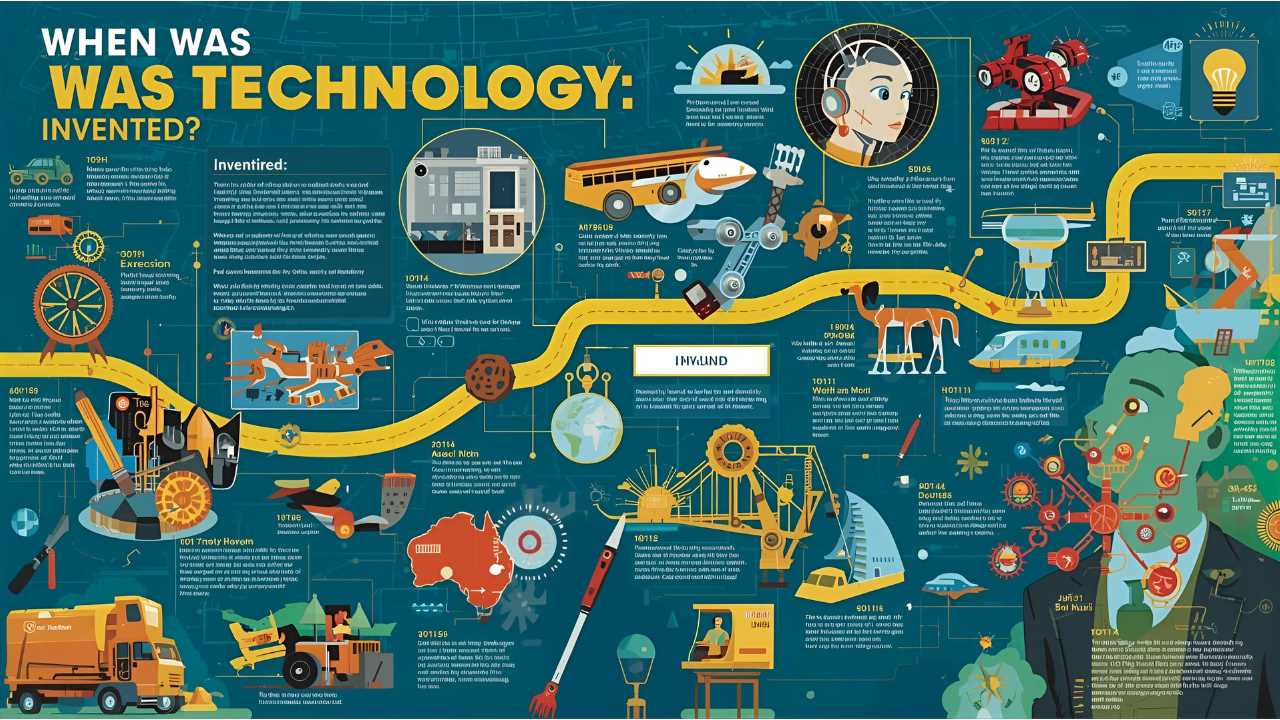When was technology invented as the tools and gadgets we use on a daily basis, such as computers, smartphones, and artificial intelligence systems. However, technology has a much longer history, involving the implements, methods, and creations that have molded human society over thousands of years. It takes more than just naming a year to determine the invention of technology; it also entails examining the slow development of human inventiveness.
The Dawn of Technology: Early Human Tools
For hundreds of thousands of years, people have used technology in a variety of ways. The first were simple implements fashioned from wood, bone, and stone. Early humans were able to hunt, gather, and survive thanks to these basic tools. These tools evolved over time, showcasing the natural human capacity for innovation and adaptation.
| Era | Technological Development | Approximate Time Period |
| Stone Age | Stone tools, hand axes, spears | 2.5 million – 3,000 BCE |
| Bronze Age | Metalworking, bronze tools | 3,300 – 1,200 BCE |
| Iron Age | Iron tools, plows, weapons | 1,200 – 600 BCE |
| Ancient Civilizations | Writing systems, irrigation, wheels | 3,500 – 500 BCE |
| Middle Ages | Windmills, watermills, mechanical clocks | 500 – 1500 CE |
| Renaissance | Printing press, scientific instruments | 14th – 17th century CE |
| Industrial Revolution | Steam engines, mechanized factories | 1760 – 1840 CE |
| Modern Era | Computers, electricity, internet | 20th – 21st century CE |
This table emphasizes how technology is a constant development of human creativity rather than a recent invention.
Stone Age Innovations
The earliest known technological developments occurred during the Stone Age. Homo habilis, or early humans, made stone tools for food preparation and hunting. Fire was another monumental invention, giving humans warmth, protection, and a means to cook. Although the main goal of technology during this time was survival, these developments set the stage for more sophisticated ones.
The Bronze and Iron Ages
The Bronze Age began when metallurgy was developed and people realized how advantageous it was to combine metals like copper and tin to make bronze. This invention transformed art, agriculture, and weapons. After this, iron—which was more robust and long-lasting than bronze—became widely used during the Iron Age. These developments made it possible for civilizations to grow and thrive.
Ancient Civilizations and Technological Growth
Early technology was greatly influenced by civilizations like Mesopotamia, Egypt, Greece, and China. The human experience was fundamentally altered by the development of the wheel, plow, and writing systems. Paper, compass, and gunpowder were invented in China centuries before they were introduced in Europe. These technological achievements demonstrate how human ingenuity has always aimed to address real-world issues.
Medieval and Renaissance Innovations
The invention of windmills, watermills, and mechanical clocks during the Middle Ages marked a technological advancement. With the invention of the printing press, which revolutionized the distribution of knowledge, the Renaissance further spurred innovation. The foundation of modern science was laid by scientific tools like telescopes and microscopes, which enabled people to investigate previously undiscovered facets of the world.
The Industrial Revolution: A Technological Explosion
An important turning point in human history was the start of the Industrial Revolution in the 18th century. New transportation networks, steam engines, and mechanized factories changed economies and societies. This period showed how technology could significantly boost output and change how people live and work.
Modern Technology: Computers and Beyond
Unprecedented technological advancements occurred in the 20th and 21st centuries. Communication, information access, and daily life have all been transformed by computers, electricity, the internet, and smartphones. The cutting edge of contemporary technology is represented by biotechnology, artificial intelligence, and space exploration, which carry on the long-standing human desire for innovation.
When was technology invented?
It is impossible to pinpoint the precise moment that technology was “invented.” Rather, technology is a dynamic spectrum. Human ingenuity has been a consistent, adaptable, and revolutionary force from the earliest stone tools to the most advanced quantum computers. Every generation builds on the findings of the one before it, proving that technology is more about the human desire to advance, adapt, and survive than it is about a single invention.
Impact of Technology on Society
From the agricultural revolution, which allowed people to settle in one location, to the industrial revolution, which led to urbanization, and to the current digital revolution, which instantly connects people worldwide, technology has always influenced society. Although technological developments have frequently raised people’s quality of life, they also bring with them problems like social inequality, privacy issues, and environmental degradation.
The Future of Technology
When was technology invented will continue to advance at an astounding rate. AI, biotechnology, renewable energy, and space exploration innovations have the potential to completely transform human life. Knowing the history of technology enables us to foresee future developments and responsibly use innovation to advance society.
FAQs about When was technology invented
Q1: When did people begin using tools?
A: Around 2.5 million years ago, humans first used basic stone tools, which signaled the start of technological advancement.
Q2: Which metal was utilized in technology for the first time?
A: One of the earliest metals used was copper, which was followed by the Bronze Age, when people mixed copper and tin to create more powerful implements.
Q3: Did prehistoric societies advance technology?
A: The wheel, plow, irrigation systems, and writing were all created by ancient civilizations, and they significantly improved society.
Q4: What effects did the Industrial Revolution have on technology?
A: The Industrial Revolution greatly accelerated technological advancement by bringing mass production, steam engines, and mechanized factories.
Q5: When did most people start using computers?
A: The development of computers started in the middle of the 20th century, and in the 1980s and 1990s, they were widely available to the general public.
Q6: Is technology limited to machines?
A: No, technology encompasses all tools, methods, and techniques created by humans to solve problems, from biotechnology and artificial intelligence to fire and stone tools.
Q7: Will technology continue to evolve?
A: Definitely. As people look for better ways to live, communicate, and explore the cosmos, technology is always changing.



